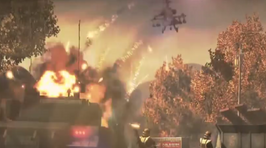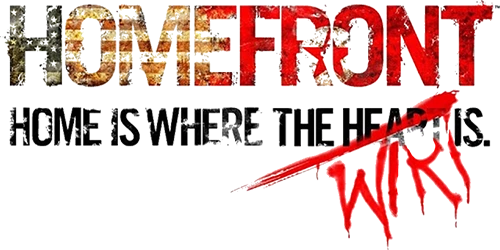The United States Armed Forces is the federal armed forces of the United States. They used to have significant power projection capabilities and defense because of the advanced weapons and the placement of troops in Europe, Asia, Africa, the Middle East and the continental United States. They are a playable faction in Homefront multiplayer.
History
Due to the burgeoning economic recession in the United States, the U.S. Department of Defense scaled down the military budget by reducing its reliance on fleets of capital ships and large-theater military conflicts.[1]. Subsequently, the U.S. military began to pull out its troops in Asia, and by 2016 the United States was forced to pull out of all its foreign installations in order to maintain domestic order. By 2017, the U.S. President enacted a policy of martial law in response to the growing disorder in the U.S. caused by the economic crisis. By 2019 the crisis had worsened, with outright anarchy in several cities, forcing the President to consider violating the Posse Comitatus Act and have the U.S. military deploy domestically to restore order.[2] The Pentagon puts forth a plan involving the military in charge of managing civilian authorities, completely supplanting the police and fire departments in many urban centers under the controversial Operation Vital Archer.[3] The military later continued to serve under martial law in the Eastern United States in response to the outbreak of the H5N1 avian influenza virus.[4]
Because of the global economic collapse and the Korean People's Army's modernization program, the U.S. military was technologically equal with the Koreans, in which the Greater Korean Republic took advantage in attacking and invading the United States in 2025. Owing to the swiftness of the unexpected attack, the Korean usage of a powerful EMP blast that catapulted America's technology back to the 1800s, and the sheer amount of soldiers the GKR had at its disposal (its total forces numbered 25 million by the time of the invasion), the Armed Forces were quickly pushed back across the Mississippi River as well as across the Canadian border, where they seemingly staved off the Koreans with aid from the Canadian military. Captured soldiers were usually either admitted into labor camps or killed, while some of the ones who escaped confinement and death either attempted to blend in with the rest of the newly-formed New Korean Federation of Occupied America or joined up with the Resistance.
In 2027, the U.S. military regrouped and successfully retook the cities of San Francisco and San Diego in its counter-offensive in the American west coast. They are currently retaking the rest of the occupied United States from the Koreans, now with help from the European Union.
Service Branches
The United States Armed Forces consist of five separate branches, the United States Air Force, Coast Guard, Army, Marine Corps, and Navy.
Ground Forces
The United States Army and Marine Corps serve all ground combat roles, just as the KPA's Ground Force does for the GKR. Both branches did whatever they could when the KPA invaded in 2025 but were at a severe disadvantage due to the EMP and were overwhelmed and forced to retreat. By 2027, U.S. ground forces were completely scattered, until the Battle of San Francisco later that year, where they joined up with Resistance fighters in a desperate effort to retake San Francisco. Many of their arms have been the same ones they have been using for decades, such as the M4, M16, M110, M249, and the PWS Diablo. They also use many of the same advanced drones the KPA Ground Force uses, like the MQ-60 AT Rhino, RQ-10 Parrot, AQ-11 Buzzard, and the MQ50 MG Wolverine. The Ground Forces still use modernized versions of the venerable LAV-25, the M1A3 Abrams, and the HMMWV as part of their arsenal.
United States Special Forces
In Homefront, the U.S. special forces are represented by the U.S. Navy SEALs. A group of Navy SEALs, SEAL Team One, is mentioned in Golden Gate. They successfully secured Alcatraz Island during the Battle of San Francisco. Additionally, AH-700 helicopters from the 160th Special Operations Aviation Regiment participated in the critical assault on the Bridge, ferrying waves of U.S. reinforcements in the face of Korean air superiority.
The U.S. Navy is the naval branch of the U.S. Armed Forces. In the years leading up to 2025 the Navy suffered heavy downsizing due to the economic situation including the decommissioning of the USS John C. Stennis and the USS Theodore Roosevelt, and refocused in policing the rampart piracy and drug smuggling that have plagued the west coast of North America.[5][6] Along with the USS John Paul Jones and USS Milius, five destroyers took part in the American counter-offensive in San Diego, where they broke through a Korean naval blockade and secured San Diego Bay. Another one of the ships may have been a nuclear submarine since there was one in the San Francisco Bay during the final chapter, Golden Gate.
In Overwatch, a partially sunken aircraft carrier is seen in Lake Tahoe. This is very strange as there is no waterway access from the Pacific Ocean to the Lake. It may be that the state government constructed a canal across California to act as a shipping lane to Carson City and Reno. The presence of a bridge used by the Resistance on the way to San Francisco may have also been created pre-invasion. Two likely causes to the presence of the aircraft carrier are that it pursued KPA forces inland and eventually succumed to attacks, or the KPA captured it, sailed it inland, and used it as a barrier to prevent the U.S. Navy from securing the Canal. The Carrier itself is either a Nimitz class or a Gerald R. Ford class.
U.S. Air Force

US army Apache attacks KPA position.
The U.S. Air Force provides air support for infantry forces using F-22 Raptors, F-35 Lightnings, and UCAVs. Some of their equipment has been seized by the Korean People's Air Force.
When the Interstate Highway system was built during the 1950s the U.S. Government requested that for every five miles of roadway, there be a mile of straight and level to serve as makeshift landing strips for military aircraft. This was engineered with the anticipation that World War III was on the horizon and that there would be a flood of military planes in the airspace across the U.S. Since the KPA have seized many key U.S.A.F. bases in the west, it is likely that scattered American squadrons use the aging interstates as runways.
Air Cavalry
The U.S. Army's Air Cavalry provides close air support with various helicopters. They usually field AH-64 Apache attack helicopters and the AH-700 Scout helicopter.
U.S. National Guard
The National Guard was the collective military of the fifty states. The National Guard were deployed to distribute aid and restore order after Martial Law was enacted, including in repairing the aging transcontinental highway system.[7][8] However, the National Guard was criticized for its perceived ineffectiveness especially in dealing with warring gangs that began to taken over urban centers and fighting the Guard.[9]
Many of their forces have scattered across America, but still conduct attacks against the KPA. They often move from state to state. In Homefront: The Voice of Freedom, Ben Walker joined up with a unit of the National Guardsmen from San Diego. They traveled throughout the country aiding resistance groups. By 2027, several National Guard formations, including the 185th Armor Regiment and the 40th Infantry Division, were still in the fight.
U.S. Coast Guard
The United States Coast Guard is a maritime, military, multi-mission service unique among the Armed Forces having both law enforcement mission and a federal regulatory agency. It is under jurisdiction from the U.S. Department of Homeland Security and when in war, under the Department of Defense. Vehicles of this branch include Coast Guard Cutters, patrol boats, planes and two types of fixed-rotor aircraft
The Coast Guard are unmentioned in the game, but it is highly likely they were mobilized to fight the invading Korean troops and evacuate American citizens living in the West Coast. This may have been done in coordination with the U.S. Navy. However, due to the massive amount of Korean soldiers that invaded the West Coast, it is assumed that remaining Coast Guard units have either been captured, killed, or scattered into packets of resistance like the other forces of the U.S. military. Also, it can be assumed that, should they still exist in a functioning capacity, they conduct raids on Korean Occupational Forces.
The Coast Guard was not mentioned during the Battle of San Francisco, and it is unknown if they too played a role in recapturing the city from the Greater Korean Republic by reinforcing the U.S. Navy and Marines.
American Resistance
Since the occupation began, American Resistance fighters have fought alongside the U.S. Armed Forces. They have also provided resources such as fuel and shelter for the troops stuck in occupied territory. During the counter-offensive in San Francisco, several Resistance fighters aided in providing three trucks of jet fuel for the military and fighting alongside them to take the Golden Gate Bridge.
Arms and Equipment
Due to the worldwide economic collapse, America's military simply did not have enough funding to re-modernize all their forces. Therefore, much of the U.S. Armed Force's equipment are the same ones they have been using since before the economic downturn, which started in 2007, 20 years before the events of Homefront. Their uniform looks the same as it does today, except with a greenish tone to it, contrasting the KPA's reddish-brown uniform. U.S. Armed Forces snipers have ghillie suits that are colored a light yellow, also contrasting the KPA's orange ghillie suits.
Weapons
Vehicles
Gallery
Trivia
- Strangely, the troops seem to be wearing a different camo from UCP from the United States Army and MARPAT from the United States Marine Corps.
Sources
- ↑ US Military to scale back, refocus
- ↑ Anarchy in the US as National Guard fails to restore order
- ↑ Suburban flight grows as martial law begins to restore order
- ↑ East Coast paralyzed as pandemic strikes population
- ↑ Aircraft carriers decommissioned, navy to downsize
- ↑ US Pacific Fleet consolidated to Pearl Harbor
- ↑ Martial Law Declared as US cities descend into chaos
- ↑ US Infrastructure crumbles as debt become unmanageable, tax revenues decline
- ↑ Anarchy in the US as National Guard fails to restore order
| |||||||||||




